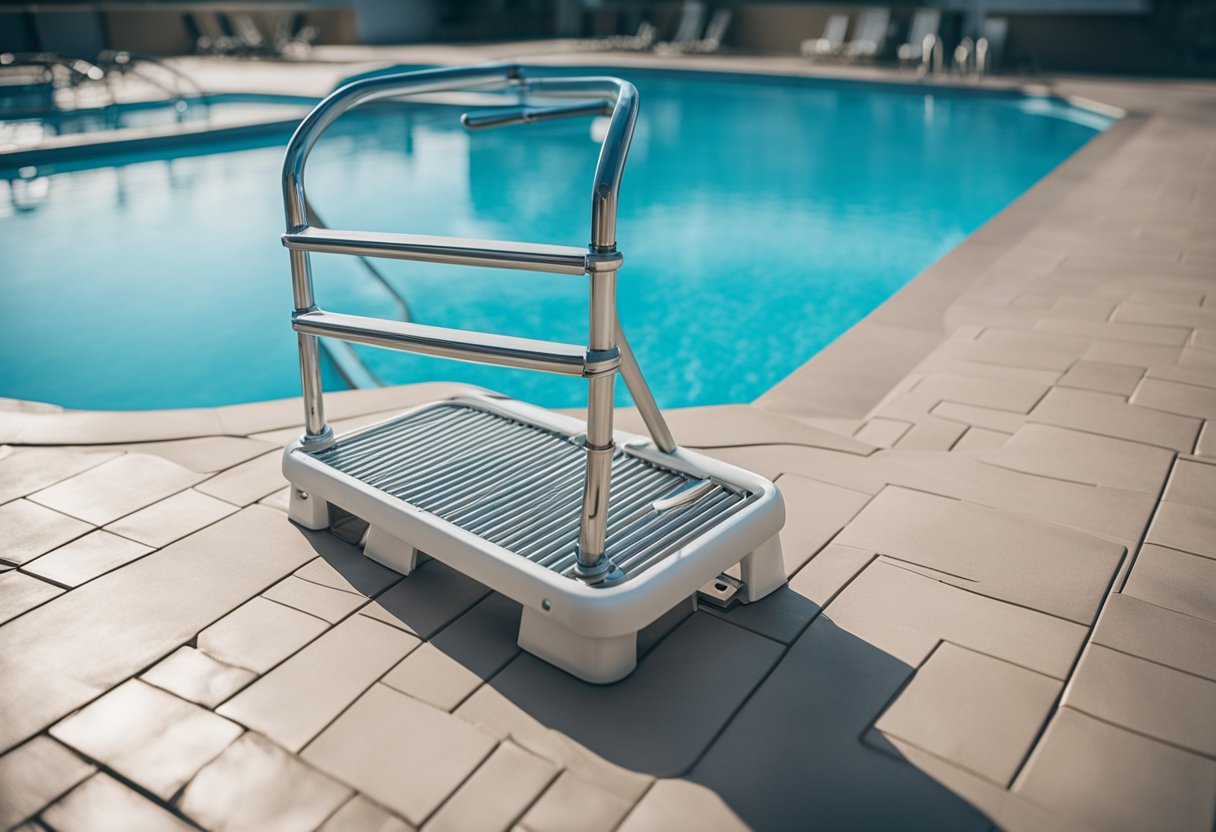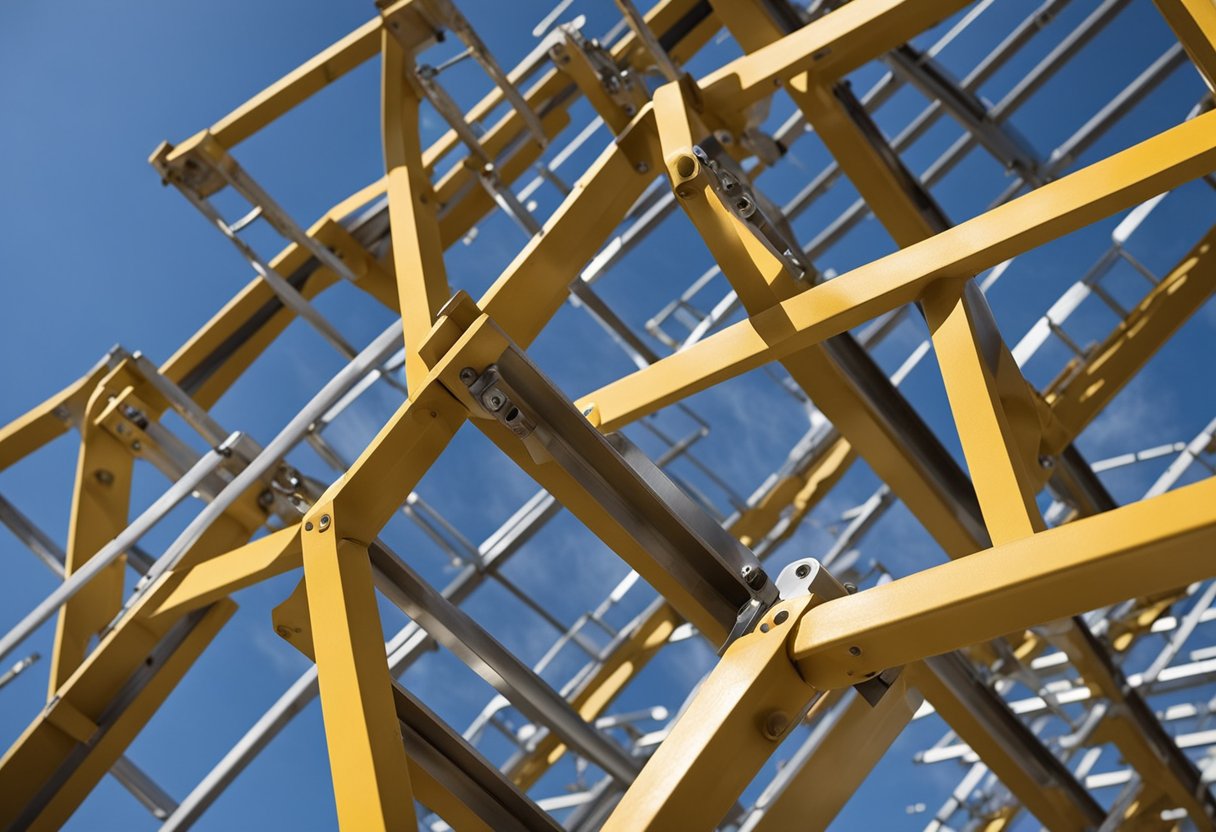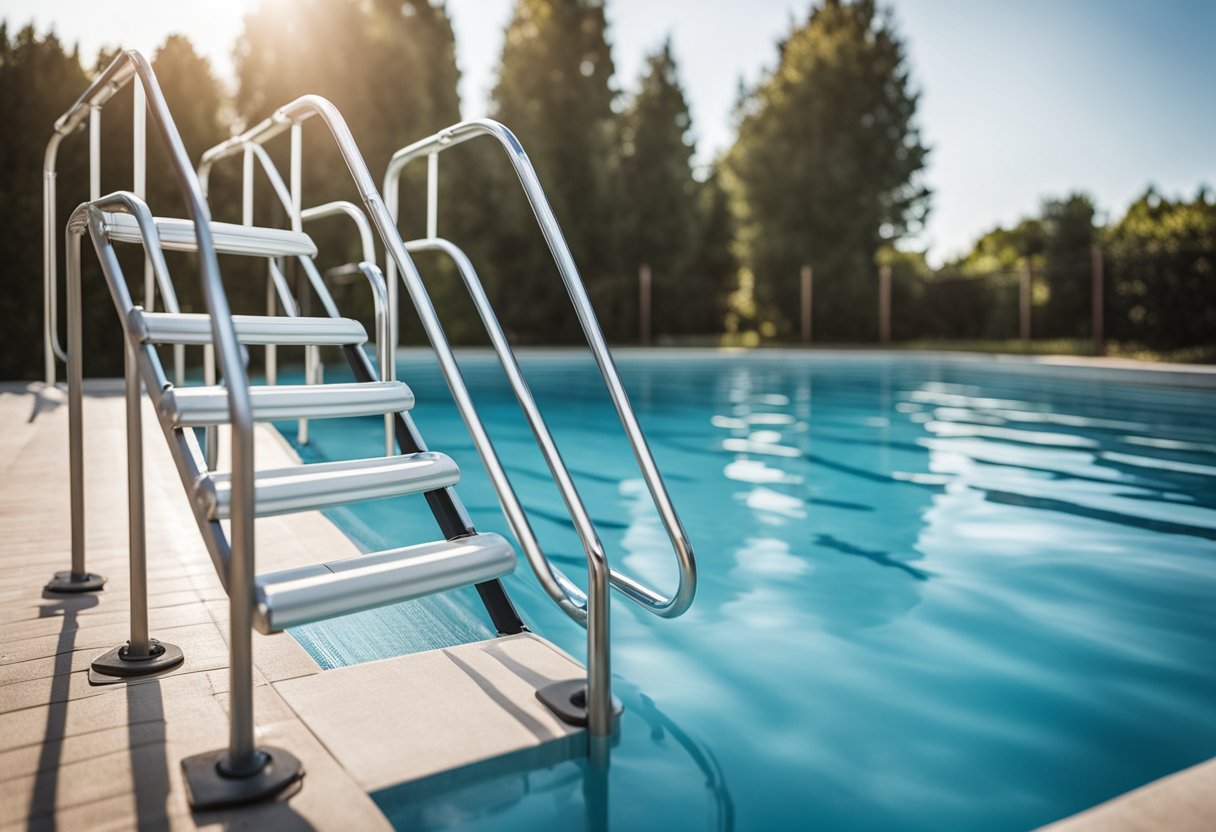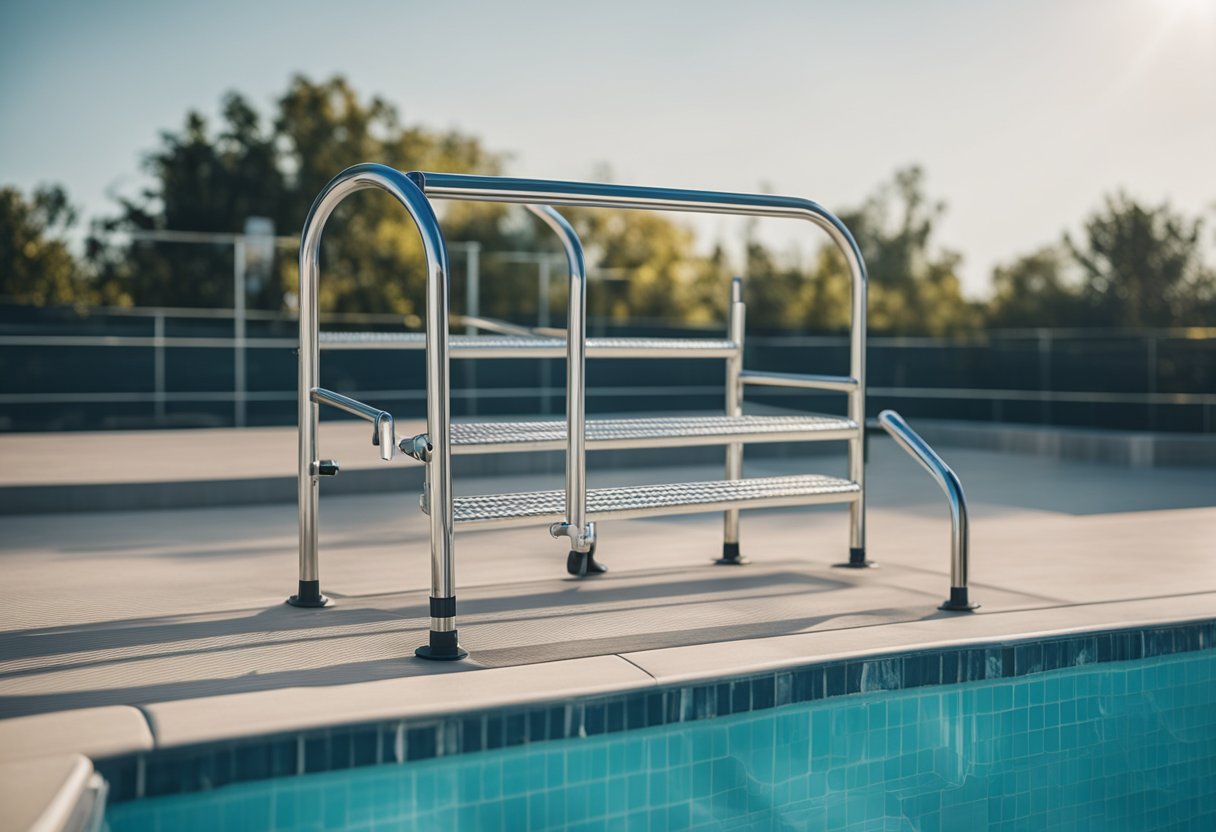As a pool owner, ensuring the safety and accessibility of your above ground pool is of utmost importance. One key component of pool safety is the stability of your pool ladder. A wobbly or unstable ladder can lead to slips, falls, and other accidents. In this article, I will provide tips and tricks on how to make an above ground pool ladder more stable, ensuring a safe and enjoyable swimming experience for you and your loved ones.
Understanding pool ladder basics is the first step in ensuring a stable and secure ladder. Choosing the right materials, installation process, and regular maintenance are all important factors in keeping your ladder in top shape. In addition, securing and stabilizing the ladder is crucial to preventing slips and falls. By following these steps and taking the necessary precautions, you can ensure that your above ground pool ladder is safe and stable for years to come.
Key Takeaways
- Understanding pool ladder basics is key to ensuring stability and safety.
- Choosing the right materials, installation process, and regular maintenance are crucial factors in keeping your ladder secure.
- Securing and stabilizing the ladder is essential to preventing slips and falls.
Understanding Pool Ladder Basics
https://www.youtube.com/watch?v=YibqFL1TKIY&embed=true
As a pool owner, I understand the importance of having a safe and stable pool ladder. A pool ladder is an essential part of any swimming pool, whether it’s an above-ground or in-ground pool. It provides easy access to the pool and ensures safety while entering and exiting the pool.
There are various types of pool ladders available in the market, including above-ground pool ladders, in-pool ladders, A-frame ladders, and in-ground pool ladders. Each type of ladder has its unique features and specifications.
A-frame ladders are the most common type of above-ground pool ladder. They are designed to rest on the pool’s top rail and provide a safe and stable way to enter and exit the pool. A-frame ladders are typically made of resin or metal and are available in different sizes and weight capacities.
In-pool ladders are another popular type of pool ladder. They are designed to be installed inside the pool and provide easy access to the pool. In-pool ladders are available in different styles, including steps and handrails, and can be made of various materials such as plastic, metal, or fiberglass.
Pool steps are another option for pool owners who want a more stable and secure way to enter and exit their pool. Pool steps are typically made of plastic or fiberglass and are designed to be installed inside the pool. They provide a larger surface area to stand on and are more stable than traditional pool ladders.
In addition to pool steps and ladders, handrails can also be installed to provide additional support and stability while entering and exiting the pool. Handrails are typically made of stainless steel or aluminum and can be installed on the pool deck or inside the pool.
Overall, understanding the basics of pool ladders is essential for any pool owner. By choosing the right type of ladder or step and ensuring it is installed correctly, you can ensure a safe and enjoyable swimming experience for everyone.
Choosing the Right Materials
When it comes to making an above ground pool ladder more stable, one of the most important factors is choosing the right materials. The materials that you choose will determine the strength, durability, and stability of your ladder. Here are some of the most commonly used materials for above ground pool ladders:
Resin
Resin is a popular material for above ground pool ladders because it is lightweight, easy to clean, and resistant to corrosion. Resin ladders are also less expensive than other types of ladders. However, resin ladders may not be as sturdy as other materials, so it’s important to choose a ladder with a strong frame and sturdy steps.
Aluminum
Aluminum is another popular material for above ground pool ladders. Aluminum ladders are lightweight, strong, and resistant to corrosion. They are also easy to clean and maintain. However, aluminum ladders can be expensive, so it’s important to choose a ladder that is within your budget.
PVC
PVC is a lightweight and durable material that is often used for above ground pool ladders. PVC ladders are easy to clean and maintain, but they may not be as sturdy as other materials. It’s important to choose a ladder with a strong frame and sturdy steps to ensure stability and safety.
Vinyl
Vinyl is a popular material for above ground pool ladders because it is lightweight, easy to clean, and resistant to corrosion. Vinyl ladders are also less expensive than other types of ladders. However, vinyl ladders may not be as sturdy as other materials, so it’s important to choose a ladder with a strong frame and sturdy steps.
Overall, when choosing the right materials for your above ground pool ladder, it’s important to consider factors such as strength, durability, and stability. By choosing a ladder with a strong frame and sturdy steps, you can ensure that your ladder is stable and safe for use.
Installation Process
https://www.youtube.com/watch?v=EhNCEFFccEI&embed=true
To make an above ground pool ladder more stable, you need to install it properly. Here is a step-by-step guide on how to install an above ground pool ladder:
-
Choose the right ladder: Select a ladder that matches your pool type, depth, and material. Make sure the ladder is easy to install and comes with all the necessary hardware.
-
Gather tools: You’ll need a drill, wrench, level, screwdriver, and pool ladder hardware. Ensure you have all the necessary tools before starting the installation process.
-
Determine the ideal ladder placement: Decide on the placement of the ladder on the pool deck. Ensure that the ladder is level and secure.
-
Assemble the ladder components: Follow the manufacturer’s instructions to assemble the ladder, connecting steps, rails, and mounting brackets. Ensure that all the components are securely fastened.
-
Attach the ladder to the pool deck: Use anchor screws, ladder anchors, or flanges to attach the ladder to the pool deck. Ensure that the ladder is level and secure.
-
Test the ladder’s stability: Test the ladder’s stability by applying pressure to different parts of the ladder. Ensure that the ladder is stable and can support the weight of multiple people.
By following these steps, you can install an above ground pool ladder that is stable and secure. It is easy to install the ladder, and you can do it yourself with the right tools and instructions.
Ensuring Safety and Accessibility
https://www.youtube.com/watch?v=tDfVsBfxHO8&embed=true
As a pool owner, ensuring safety and accessibility for swimmers is of utmost importance. One way to achieve this is by making the above ground pool ladder more stable. A stable ladder not only prevents accidents but also makes it easier for children and elderly individuals to access the pool. Here are some tips to ensure safety and accessibility:
Check the Weight Capacity
Before installing the ladder, it is important to check the weight capacity. Most above ground pool ladders have a weight capacity of 300-350 pounds. However, it is always better to check the manufacturer’s instructions to ensure that the ladder can support the weight of all swimmers.
Use a Barrier
Attaching a barrier to the ladder is an effective safety feature. The barrier blocks the ladder’s steps and deters children from attempting unsupported climbs when the pool is unattended. The barrier also prevents small animals from entering the pool area.
Use Locking Mechanisms
Installing locking mechanisms on the ladder ensures that the ladder cannot be moved or removed easily. This is especially important if you have small children or pets at home. A padlock can also be used to secure the ladder when the pool is not in use.
Use Mats
Placing mats around the pool ladder is another safety feature that can prevent slips and falls. Mats provide a non-slip surface and absorb water, preventing the surrounding area from becoming slippery.
Ensure Accessibility
Finally, it is important to ensure that the ladder is easily accessible for all swimmers. The ladder should be placed near the edge of the pool, ensuring it is firmly on the ground and not wobbly. Make sure there is enough space around the ladder for easy access and exit.
By following these safety precautions, you can make your above ground pool ladder safe and secure for all swimmers.
Preventing Slips and Falls
https://www.youtube.com/watch?v=uYF7cyZK_9I&embed=true
When it comes to an above ground pool ladder, safety is of utmost importance. One of the biggest risks associated with pool ladders is the potential for slips and falls. To prevent accidents and injuries, it is crucial to take steps to increase the stability of your pool ladder.
First, consider adding anti-slip treads or grip pads to each rung of the ladder. Slippery ladder rungs can pose a significant safety risk, and these adhesive strips are an easy and affordable way to provide traction and prevent accidents. Additionally, installing handrails can provide extra support and stability, especially for those who may have difficulty climbing or descending the ladder.
Another important factor to consider is the placement of the ladder itself. Ensure that the ladder is placed on a flat, level surface, free from any obstacles or obstructions that could pose a tripping hazard. Additionally, consider adding pool ladder pads to the bottom of the ladder legs. These pads can create friction between the ladder and the pool floor, preventing potential slips when climbing and protecting your pool liner from ladder movements and potential damage.
Finally, consider using ladder locks to reinforce the pool ladder’s stability. These locks can be easily installed and can prevent the ladder from shifting or wobbling during use, reducing the risk of falls and injuries.
By taking these simple steps, you can greatly increase the safety and stability of your above ground pool ladder, reducing the risk of accidents, injuries, and falls.
Securing and Stabilizing the Pool Ladder
https://www.youtube.com/watch?v=3KOgijvL2kg&embed=true
As an above ground pool owner, ensuring the safety of everyone using the pool is a top priority. One way to do this is by securing and stabilizing the pool ladder. A wobbling or shaking ladder with loose connections can be dangerous, especially for children and the elderly. Here are some ways to make your above ground pool ladder more stable and secure.
Use Straps or Sandbags
One effective way to stabilize the ladder is by using straps or sandbags. Straps can be attached to the ladder and the pool’s frame to keep it in place. Sandbags can be placed at the base of the ladder to anchor it to the ground. This prevents the ladder from shifting or tipping over while in use.
Inspect and Tighten Loose Connections
Inspect the ladder for any loose connections and tighten them if necessary. Loose bolts or screws can cause the ladder to wobble or shake, making it unstable. Check the ladder periodically to ensure that all connections are tight and secure.
Install Anti-Slip Treads or Grip Pads
Slippery ladder rungs can pose a significant safety risk, especially when wet. To prevent slips and falls, install anti-slip treads or grip pads on the ladder rungs. These can be purchased at most pool supply stores and are easy to install.
Consider Ladder Locks
Ladder locks can additionally reinforce the pool ladder’s stability. They can hold the ladder immobile, preventing swaying or slipping, and also act as a child safety feature, locking the ladder to discourage unsupervised climbing.
In conclusion, securing and stabilizing your above ground pool ladder is essential for maintaining a safe swimming environment. By following these tips, you can ensure that your ladder is secure and stable, and everyone can enjoy the pool safely.
Regular Maintenance and Inspection
As with any equipment, regular maintenance and inspection are crucial for ensuring the stability and safety of your above ground pool ladder. Ideally, you should inspect your ladder at the beginning and end of each season, as well as after any major storms or heavy use.
During your inspection, check for any signs of wear and tear, such as loose bolts or rust. If you notice any damage, it’s important to repair or replace the ladder as soon as possible to prevent any accidents.
In addition to checking for damage, you should also make sure that all bolts and screws are tight and secure. Loose bolts can cause the ladder to wobble or shift, which can be dangerous for anyone using it.
Regular maintenance also includes cleaning the ladder regularly to prevent the buildup of dirt and grime, which can make the ladder slippery and unsafe. Use a mild detergent and a soft brush to clean the ladder, and rinse thoroughly with a hose.
By performing regular maintenance and inspection, you can help ensure that your above ground pool ladder remains stable and safe for years to come.
Additional Pool Accessories
In addition to stabilizing your above ground pool ladder, there are a few other pool accessories that can help improve safety and stability.
Pool Steps
Pool steps are a great addition to any above ground pool. They provide a sturdy and stable way to enter and exit the pool. They come in a variety of styles, including drop-in steps, side-mounted steps, and molded steps. Drop-in steps are designed to fit into the existing pool structure, while side-mounted steps attach to the pool wall. Molded steps are built into the pool structure and provide a seamless look.
Pool Handrails
Pool handrails are another accessory that can improve safety and stability. They provide a secure way to enter and exit the pool, especially for those with limited mobility or balance issues. Handrails can be installed on both sides of the pool ladder or on the pool deck itself.
DIY Pool Accessories
If you’re handy and looking to save some money, there are a few DIY pool accessories you can make to improve stability. For example, you can create a pool noodle cover for your ladder to prevent slipping. You can also create a non-slip surface on your ladder steps using sandpaper or adhesive strips.
Overall, adding additional pool accessories can help improve safety and stability when entering and exiting your above ground pool. Consider your specific needs and budget when selecting accessories, and always follow manufacturer instructions when installing.
Frequently Asked Questions
How can I stabilize my above ground pool ladder?
To stabilize your above ground pool ladder, you can add sandbags or weights to the base of the ladder. This will anchor the ladder to the ground and prevent it from wobbling. You can also try securing the ladder to the pool wall using clamps or brackets.
How do I prevent my above ground pool ladder from wobbling?
To prevent your above ground pool ladder from wobbling, make sure it is positioned correctly and on level ground. If the ladder is still unstable, you can add stability by securing the base of the ladder to the ground or the pool wall.
What options are available for making my pool ladder more stable?
There are several options available for making your above ground pool ladder more stable. You can add sandbags or weights to the base of the ladder, secure the ladder to the pool wall using clamps or brackets, or install a ladder stabilizer bar.
Are there any DIY solutions for stabilizing an above ground pool ladder?
Yes, there are several DIY solutions for stabilizing an above ground pool ladder. You can use PVC pipes to create a ladder stabilizer bar, or you can use pool noodles to wrap around the ladder legs to prevent wobbling.
Can I add weights to my above ground pool ladder to make it more stable?
Yes, you can add weights to your above ground pool ladder to make it more stable. Sandbags or weights can be added to the base of the ladder to anchor it to the ground.
What are some common parts that may need to be replaced to improve the stability of my above ground pool ladder?
If your above ground pool ladder is unstable, you may need to replace some of its parts. Common parts that may need to be replaced include ladder treads, ladder steps, ladder feet, and ladder hinges.

Hi, I’m Sal Muller of Tooltrip.com. My DIY experience led me to understand essential power tools for home projects. Tooltrip.com guides enthusiasts and professionals in choosing right tools for any job. I provide concise top tool reviews for easier, efficient DIY.






